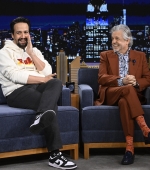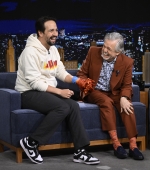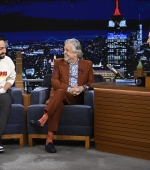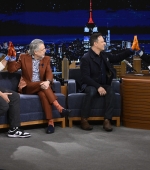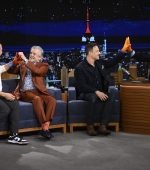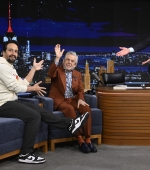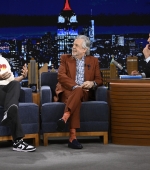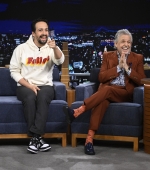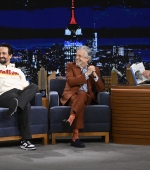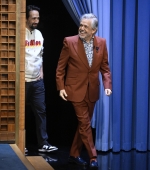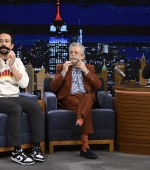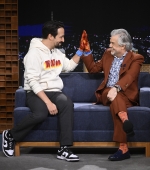A new article from The New York Times helps to shine a light on what happens in Puerto Rico with Hamilton, since, as we know, the production had to relocate from the theatre at the University of Puerto Rico to the Centro de Bellas Artes Luis A. Ferrè.
Michael Paulson followed Miranda during his trip in Puerto Rico to unveil a Coffee Development Initiative back in October.
Check the pictures in our Gallery.
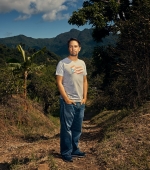
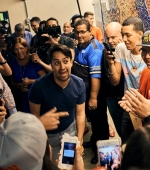
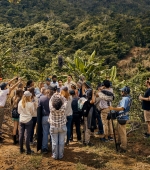
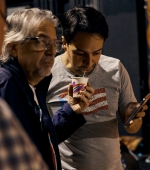
VEGA ALTA, P.R. — The road to Vega Alta is lined with Lin-Manuel Miranda. Literally.
Just next to the arched stone welcome sign is a billboard with a large photo of the “Hamilton” creator, and a hashtag — #YoSoyVegaAlta — meaning “I am Vega Alta.”
This is the town where his father is from, where he and his sister spent summers as kids, where their aunt and uncle still live. It’s also a community that has seen better days — challenged by joblessness and crime and a town center dotted with vacancies.
Now, at the heart of the commercial district, in a space that once housed a disco called the Pink Panther, is La Placita de Güisin, an arcade built by Luis Miranda, Lin-Manuel’s father, who left for New York when he was 18, but never stopped coming back. It features a bakery, a barista and a cafe; there is a gift shop selling Lin-Manuel Miranda merchandise (yes, he has a merchandise line), as well as a mosaic mural depicting him and his grandfather.
Mr. Miranda, preparing to reassume the title role of “Hamilton” for a three-week run that begins in San Juan on Jan. 11, arrived in Vega Alta one rainy Tuesday night this fall like the celebrity he has become. He and his father, accompanied by publicists and staffers and a documentary film crew, took a private plane to the island and then a black S.U.V. to Vega Alta, where they were celebrating local arts organizations the family is assisting as part of their intensified philanthropic efforts in the aftermath of Hurricane Maria, which slammed into Puerto Rico last year.
A dozen amped-up adolescents, some wearing A. Ham hats, cornered him by the mural and, from memory (O.K., one or two of them were peeking at cellphone screens), performed an a cappella version of the musical’s opening number, led by their high school English teacher, Edd Ramos, who has been using the show’s coffee-table tome as a textbook.
Mr. Miranda, sporting Spider-Man sneakers, leapt into the scrum, singing and dancing along with the teenagers, videotaping them as they videotaped him. Then, under a tent erected over a side street, he and his father sat in the front row, nodding their heads and joining the crowd as the singer-songwriter Antonio Cabán Vale, known as El Topo, performed “Verde Luz,” a danza that has come to symbolize Puerto Rican pride.
“He’s like a lighthouse for Puerto Rico now,” said one of the many assembled well-wishers, Alejandro García Padilla, a former governor of Puerto Rico. Mr. García Padilla is an unabashed fan who plays the “Hamilton” cast album in the car while driving his kids to school and has not only seen the musical twice in New York but has also stopped by Trinity Church to visit Alexander Hamilton’s grave. “He is worldwide famous, but he cares about his people, he cares about his country, he cares about Puerto Rico. He doesn’t forget about us.”
But even lighthouses get battered by waves.
Read the rest of the article under the cut.
Mr. Miranda’s passion for Puerto Rico has also led to controversy — particularly because he supported a debt restructuring plan that is overseen by an unpopular federal oversight board, and then chose a theater for “Hamilton” at the University of Puerto Rico, which is being roiled by the board’s fiscal plan as well as a union dispute. For some, the musical, a blockbuster hit about colonists fighting for independence, offered a tempting opportunity to call attention to their concerns.
So earlier this month, with Mr. Miranda’s blessing but also to his great disappointment, the producers of “Hamilton” decided to relocate the San Juan production from the demonstration-prone university to an easier-to-secure off-campus theater.
‘Questions He’s Always Thinking About’
Lin-Manuel Miranda is a New Yorker, born and bred. He has spent most of his nearly 39 years living in Upper Manhattan; he attended New York public schools, and his career was established on New York’s stages.
But Puerto Rico offers a thread, a theme, a thesis for his life. It’s the homeland where both of his parents grew up. It’s the place he long idealized, where many now idealize him.
As we talked about how Puerto Rico shaped his personal, political and artistic identity, he mused aloud about questions he has grappled with. What does it mean to feel nostalgia for a place you never lived, a place your parents loved but left? How does fame affect the way you see, and are seen, in that place?
“I believe I owe a great deal of who I am to this island,” he said as we drove from a coffee plantation deep in the mountains to the theater in San Juan where he hoped “Hamilton” would be staged.
“It’s a tactile thing. It’s a tempo thing. It’s the pace of life here,” he said when I asked what about Puerto Rico he would want to pass along to his own children — two sons, both very young. “It’s the way the world sounds at night. It’s seeing the stars. It’s this oneness with nature that is very natural and real. It is all the things you cannot get in New York City. And it is its culture, because the kindest people I know are here.”
His identification with this United States commonwealth 1,600 miles south of New York has informed his biggest successes — “In the Heights,” about a Caribbean-American community formed around a bodega in Northern Manhattan, and “Hamilton,” whose title character is a Caribbean immigrant who becomes an American founding father.
“This idea of who you are in one place, and how different or similar that is to who you are in another place, has been present from the first conversation I had with him,” said Thomas Kail, one of Mr. Miranda’s closest creative collaborators, a fellow Wesleyan University alumnus who directed both “Heights” and “Hamilton.”
Sign up for the Theater Update Newsletter
Every week, stay on top of the top-grossing Broadway shows, recent reviews, Critics’ Picks and more.SIGN UP
“It’s something Lin writes about in all of his shows — ‘Who am I?’, ‘Where am I from?’ and ‘Have I done enough’?” Mr. Kail said. “Those are the questions he’s always thinking about.”Mr. Miranda first visited Vega Alta, which is about 20 miles west of San Juan, as an 8-week-old infant, and later he started spending a month in the town every summer, accompanied by his sister.
Days were occupied with his grandmother, who ran a travel agency, and his grandfather, a manager at the credit union. There were hours exploring — trying to catch lizards; marveling at the moriviví, a plant that shrinks from human touch; savoring quenepas, a tropical fruit (as well as Chef Boyardee and McDonald’s French fries).
“It’s the closest thing I have to literally a town where everybody knows your name,” Mr. Miranda said.
As he got a little older, he indulged a growing passion: filmmaking. His grandfather borrowed a security camera from the credit union, and Mr. Miranda used it to shoot battles between G.I. Joes, explosions of blood capsules, and, memorably, a scene in which he tossed a fake body, fashioned out of stuffed clothing, from his grandparents’ roof, alarming the woman next door, who at first did not realize the body was a prop.
That neighbor, Margot Rodríguez, was often featured in Mr. Miranda’s films — she would pretend to faint, or to sing, or to play the guitar. “He was like my son,” she said. “My beloved nene.”
His aunt, Yamilla Miranda, described him as a “funny kid.”
“You expect a kid to run and to play and to be with the other kids,” she said, “but he was reading, and he loved to play video games, and there was his film — all day, making films.”
Celebrity and Charity
It was mucky atop the mountain.
Hurricane Maria had stripped the hillsides, and now it had been raining, so photographers were stumbling into the red mud as they scrambled to get photos of Mr. Miranda next to a newly planted coffee bush, Mr. Miranda with a ripening bean, Mr. Miranda beside executives from Starbucks and Nespresso and the Rockefeller Foundation, all pledging to help him help the island’s storm-battered coffee industry.
He was witty, worrying aloud about the safety of a bush when a slip-sliding journalist reached out to steady himself. He was revealing, rolling up his jeans to show off a new coffee-cup tattoo on his ankle. He was sweating in his gray Puerto Rican scholarship fund T-shirt, but he turned on the charm — embracing farmers, thanking donors, listening attentively to discussion of fungus infestation and seed regulation.
And he was relentlessly on message: Puerto Rico needs help.
“A year ago, this island changed forever,” he said at the small family-owned coffee farm in Jayuya. “We’re going to have their backs.”
“Hamilton” has given him both resources — he’s making millions of dollars a year — and renown — access to princes and presidents, magazine covers and movie deals.
Mr. Miranda’s philanthropy, which he conducts in collaboration with his family, is still taking shape but is growing fast. Over the last two years, the Mirandas have given more than $4.6 million to nonprofits and have raised another $8 million, after expenses, through sweepstakes campaigns for a variety of causes, according to Sara Elisa Miller, the family’s director of philanthropy.
Their interests are varied, including developing artists of color; encouraging political involvement by Latinos; and supporting voting rights, immigrants, women’s health and education. And in the wake of Hurricane Maria, which killed about 3,000 people and caused damage to the island’s infrastructure and economy, they have been especially focused on helping Puerto Rico.
“It needs help, and it needs attention,” Mr. Miranda said, “and one of the weird side effects of ‘Hamilton’ is this megaphone that I didn’t really know what to do with in the beginning.”
That megaphone means that Mr. Miranda is a signal booster, able to use his visibility and his huge social media following to call attention to issues and causes. After the hurricane, the Mirandas helped raised $43 million for the Hispanic Federation’s hurricane relief fund — an effort that was inadvertently boosted when Mr. Miranda, in an uncharacteristic outburst, said on Twitter that President Trump would go to hell for criticizing the San Juan mayor — and also helped with a toy drive that delivered 40,000 Three Kings’ Day gifts to Puerto Rican children.
More recently, the family has turned to shoring up Puerto Rican artists, setting up a fund through the Flamboyan Foundation through which they hope to raise and distribute $15 million. That money is to come largely from the Puerto Rico “Hamilton” production, in part through the sale of premium tickets (about 3,000 at $5,000 apiece, and there are also pricey tour packages), corporate sponsorships, and any profits from the San Juan run. (There are also cheap tickets: 10,000 seats — about one-fourth of the total — are being sold for $10 each.)
Mr. Miranda is using the event to promote tourism, too. He lured Jimmy Fallon’s “Tonight Show” to broadcast from Puerto Rico during the “Hamilton” run, with a promise that it will be a celebration of the island and its people.
For Mr. Miranda, figuring out how his heritage would influence his art, and his activism, started early, and took some time.
He grew up — in the words of Quiara Alegría Hudes, his co-author on “In the Heights” — “a Nuyorican hip-hop-raised whiz kid,” and has often described “code-switching” from an early age, as he shuttled between his predominantly Hispanic childhood neighborhood (Inwood) and the overwhelmingly white precincts surrounding his schools on the Upper East Side. (He attended Hunter elementary and high schools, public schools for gifted students.)
Characters in the musicals he wrote in high school “would have Latino surnames, but there wasn’t anything particularly Latino about them,” he said. But at Wesleyan, he moved into La Casa de Albizu Campos, a house for Latino students named for a Puerto Rican nationalist, and honed his voice.
“In that house, I really met other kids who were like me — who were first generation, very driven, but could speak to every side of pop culture — to Marc Anthony, Ricky Martin and J. Lo, along with the American culture we all grew up with,” he said.
He started writing “In the Heights” as an undergraduate, and in 2008, the night he won a Tony Award for that show’s score, he rapped his acceptance speech and then, holding the statuette aloft in his left hand, reached into the pocket of his tuxedo, pulled out a small Puerto Rican flag and waved it in the air.
“It’s a bat signal to your countrymen to say, ‘I’m up here, and you can be here too,’” he said.
“In the Heights” established his career; “Hamilton” established his fame. He lives in Washington Heights, still rides the subway (and the bus), but, by his own acknowledgment, his life “has changed very dramatically.”
Not that he’s complaining. “You’re not going to get any griping about being a celebrity from me,” he said. “Tommy Kail would probably say, ‘Lin was always this famous in his own mind, and the rest of the world caught up.’ And that’s not untrue.”
He is a very busy man. He is starring in movies (“Mary Poppins Returns”) and television (“His Dark Materials”). He is directing (“Tick, Tick … Boom!”) and producing (“Fosse/Verdon”). He even published a book of collected tweets.
A film adaptation of “In the Heights” is in development, and a live-capture filming of “Hamilton” is edited and sitting in a vault, waiting until the show’s producers feel the time is right for release.
In January, immediately after the “Hamilton” run ends in Puerto Rico, he will help to present a run of “Freestyle Love Supreme,” the improvisational rap group he co-founded. (He will also appear occasionally as a guest star.) And, intriguingly, he said he is hoping to produce plays on Broadway.
He’s also always writing. “I still have ideas for musicals — I don’t know whether they’re film musicals or stage musicals, but I’m just going to write them the way I wrote ‘Hamilton’ and see what they come out as,” he said. He declined to share the topics, but said, “I promise you history is nowhere near any of them. Every historian is throwing their books at me, and I’m doing none of those.”
When I ask why he has so many projects, he dismisses the question with self-deprecation. “I am the laziest Miranda,” he said, “and the laziest Miranda still gets a lot done.”
A Plan Turned Upside Down
Mr. Miranda wheeled around, turning his back on the two dozen publicists and filmmakers and sponsors and well-wishers jockeying for a moment, a word, a selfie.
He was standing in the theater at the University of Puerto Rico’s Río Piedras campus, where he expected to perform “Hamilton,” and just for a moment, he tuned them all out. He looked out beyond the lip of the stage, surveyed the repaired roof and the new rigging, took a deep breath, and aimed his voice beyond the orchestra and up into the balcony.
“The world turned upside down” he bellowed across the cavernous, empty auditorium, testing an evocative “Hamilton” lyric.
Impressed by what he was seeing, he delivered a satisfied assessment. “This’ll do.”
But it wouldn’t.
San Juan is not on the regular circuit for touring Broadway shows. It’s expensive and time-consuming to transport sets by boat, and the local economy is too weak to support long runs.
But there was really never a question that “Hamilton” would come to Puerto Rico.
“In the Heights” had played San Juan for a week in 2010, with Mr. Miranda, who had played the leading role on Broadway, jumping into the cast of the touring production so he could perform on the island that shaped him.
“It was the most satisfying creative experience of my life,” he said. “It closed a circle I didn’t know was open — I didn’t realize how important it was to me that this island I love so much support my work.”
So “Hamilton” would come, too. The run in Puerto Rico would kick off the sixth production of “Hamilton.” Mr. Miranda would play Alexander Hamilton only in San Juan; then when the rest of the cast heads to California for a long run in San Francisco, another actor would play the title character.
Luis Miranda, a graduate of the University of Puerto Rico, was eager for “Hamilton” to play at his alma mater, hoping to burnish its reputation and show that its theater could host touring Broadway shows.
But the university has long been a hotbed of protest — Luis Miranda himself participated in protests when he was a student — and in recent years, it has been convulsed by a budget crisis that has led to proposals for rising student fees and declining staff benefits. A union representing university staffers is at loggerheads with the administration, and late last month its leadership sent Mr. Miranda a letter warning that “large-scale conflict” could affect the musical production.
At the same time, Mr. Miranda’s 2016 support for the controversial debt plan, known as Promesa, has made him a target for criticism from some Puerto Ricans. Last year, five students stormed the stage, shouting slogans, during a question-and-answer session with him on campus.
“Lin-Manuel, our lives are not your theater,” read one of their handmade signs.
“The only artists and people that benefit from ‘Hamilton’ are the elite, white North American settlers, the rich bourgeoise and those who actively participate and aspire to become oppressors,” said Ruth Figueroa, a student of comparative literature and one of the protesters. She was critical of Mr. Miranda’s stands on fiscal issues, worried that accommodating “Hamilton” would drain resources needed elsewhere and unimpressed by the choice of Alexander Hamilton as the subject for a biomusical by a Latino artist.
“As a Latin person, he should be more conscious of who Hamilton was — he’s glorifying a person that represents oppression,” she said. “He could have made a show about Harriet Tubman.”
Mr. Miranda, who now advocates debt forgiveness for Puerto Rico, said he understands the concerns about Promesa and had no problem with the protesters. “I believe the criticisms of everything that came after are valid, but I also, in that moment, didn’t see other options,” he said.
I met with 14 theater and music students while visiting the university, and they expressed a swirl of conflicting emotions about “Hamilton” — enthusiasm for the artistry, gratitude for Mr. Miranda, but also resentment that “Hamilton” appeared to be showered with resources when their academic departments were being cut back, and disappointment that more of them were not given opportunities to work on the show.
None of them expressed an intention to protest; all of them said they were hoping to see the show, and four were later offered unpaid internships with the production.
The campus’s acting chancellor, Luis A. Ferrao, thought the concern about protest was overblown. “Anything that would have arisen could have been taken care of,” he said. “No one dies because someone yells or carries a sign against whatever.”
But the Mirandas and the producers of “Hamilton” were rattled. Even though union leaders told Luis Miranda they would not protest during the production, the “Hamilton” team was not sure union members would follow suit, and there were rumblings of possible student action.
There is also a longstanding practice in Puerto Rico restricting police access to college campuses, which created a concern about how long it would take to get law enforcement assistance if needed. “We all felt 99.99 percent sure that all we were going to get were protests, and that’s fine, but there’s always that .01 percent possibility that a handful of people escalate something, and that’s a risk we were not going to run,” Luis Miranda said.
So on Dec. 21 — after having spent $1 million to repair the university theater’s storm-damaged roof and upgrade its systems, and having already loaded in the “Hamilton” set — the show’s lead producer announced that he was relocating the production to the Centro de Bellas Artes Luis A. Ferré, the San Juan theater where “In the Heights” had run.
Students are stunned and upset. “I’m certainly in shock and deeply disappointed,” said Alondra Llompart. Then on Dec. 23, the presidents of student organizations at the university’s many campuses released a statement asking the production to reconsider.
Mr. Miranda is left making peace with the contradictions — melding his pride in this place, and its pride in him, with the messy realities of a politically charged island that is struggling to recover from hurts both recent and historic.
For the moment, he is far from the tumult. Having wrapped up promotional duties for “Mary Poppins Returns” that took him around the world, he has been practicing the “Hamilton” role in his Manhattan laundry room.
“I have no agenda for Puerto Rico other than I want it to be proud of me,” he said. “All my efforts here are just to help the island in the best way I know how.”
